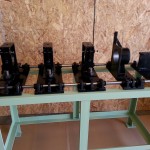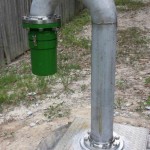Metal fabrication is the building of metal structures by cutting, bending, and assembling processes. It is a value added process that involves the construction of machines and structures from various raw materials. We are able to offer additional value to our customers by limiting the need for purchasing personnel to locate multiple vendors for different services. Typical fabrication projects include loose parts, structural frames for buildings and heavy equipment, and even full machine/equipment fabrication.
Fabrication includes cutting, bending and assembling with various types of equipment including, Shear Cutter, Plasma/Torch Cutting, Automatic Saws, and Press Brakes to name a few. There is often time an overlap in capabilities with fabricating and machining where fabrication concentrates on the metal preparation and assembly and maching tend to be more concerned with machining parts to be assembled.
We have the capability here to cut parts using a 13” x 20” Automatic Saw, or shearing metal with our 10ft Shear Cutter which cuts up to ¼” sheet metal. We can also form or bend parts with our 220 ton press brake with a 12ft bed. It has the ability to bend up to 1.25” thick material.
Welding is a fabrication or sculptural process that joins materials, usually metals or thermoplastics, by causing fusion. In addition to melting the base metal, a filler material is often added to the joint to form a pool of molten material (the weld pool) that cools to form a joint that can be as strong, or even stronger, than the base material. Pressure may also be used in conjunction with heat, or by itself, to produce a weld.
Some of the best known welding methods include:
- Shielded metal arc welding (SMAW) – also known as “stick welding or electric welding”, uses an electrode that has flux around it to protect the weld puddle. The electrode holder holds the electrode as it slowly melts away. Slag protects the weld puddle from atmospheric contamination.
- Gas tungsten arc welding (GTAW) – also known as TIG (tungsten, inert gas), uses a non-consumable tungsten electrode to produce the weld. The weld area is protected from atmospheric contamination by an inert shielding gas such as argon or helium.
- Gas metal arc welding (GMAW) – commonly termed MIG (metal, inert gas), uses a wire feeding gun that feeds wire at an adjustable speed and flows an argon-based shielding gas or a mix of argon and carbon dioxide (CO2) over the weld puddle to protect it from atmospheric contamination.
- Flux-cored arc welding (FCAW) – almost identical to MIG welding except it uses a special tubular wire filled with flux; it can be used with or without shielding gas, depending on the filler.
Welding is a large part of steel fabrication. After parts have been cut, formed and machined, assemblies are then tack welded into place before checking for accuracy. After consulting the engineering drawings to ensure precision the welder then completes the welding as specified. We have the equipment and keep welders on staff who know how to TIG, MIG and Stick Weld.





